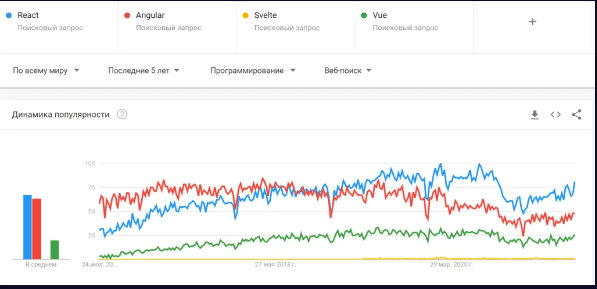- Home
- Design and Development
- Svelte vs Vue: Top Front-End Frameworks...

Web developers today face a daunting task when choosing a frontend framework. In the past, the decision was simpler, with only Angular (2010) and Vue.js (2014) on the scene. However, the landscape has evolved, and now developers must weigh the merits of Angular, React, Vue, and the relatively new contender, Svelte.
In this article, we delve into the intricacies of these frameworks, exploring their features, use cases, pros, and cons. By the end, you’ll have a comprehensive understanding of which framework aligns best with your development goals.
Svelte, created by Rich Harris, is described as “a framework without the framework.” Unlike traditional frameworks, Svelte operates as a compiler, generating components during the build stage. This unique approach eliminates the need for a virtual DOM and reduces runtime frameworks, setting it apart in the Angular vs. React vs. Vue vs. Svelte debate.
Svelte finds its niche in various scenarios, including:
Noteworthy companies adopting Svelte include:
In a Svelte.js vs. Vue comparison, Svelte stands out with several advantages:

Svelte vs Vue
However, Svelte has its drawbacks, such as:

vue.js
Vue.js, positioned as a seasoned player, combines features from Angular and React. It stands out in the Svelte.js vs. Vue showdown due to its versatility and extensive community support.
Vue proves versatile, suitable for a range of applications, including:
Vue boasts an impressive user base, with apps like:

vue.js
Vue.js offers several advantages, including:
However, Vue.js has its drawbacks, such as:
The perpetual debate over frontend frameworks involves Angular, React, Vue, and the emerging Svelte. Each has its strengths and weaknesses, making it crucial to align your choice with project requirements.

Pros of Angular
Angular boasts advantages such as:
On the flip side, Angular has its drawbacks, including:
React shines with advantages like:
However, React has its downsides, such as:
Svelte’s performance is a standout feature, thanks to its compiler nature and absence of a virtual DOM. With a focus on direct rendering, Svelte achieves exceptional speed and efficiency.
Vue, employing a virtual DOM, exhibits solid performance. Lazy loading is a notable feature, enhancing page loading speed by deferring non-critical resource rendering until needed.
In a RealWorld comparison of frontend frameworks, Svelte scores exceptionally high (99), while Vue also performs well with a score of 86. The difference, though noticeable, may not significantly impact lightweight apps but becomes perceptible in larger applications or mobile games.
Svelte’s architecture differs by directly rendering pages and generating app components through compilation. This approach streamlines runtime and influences app performance positively.
Vue follows the ViewModel method, incorporating two-way data binding in the MVVM model. Its architecture comprises Filters and Directives, enhancing flexibility by allowing developers to create custom directives.
Svelte excels in building smaller apps due to its lightweight nature and absence of a dependencies section. This feature contributes to faster loading times and improved parsing.
Vue, while relatively lightweight, falls within the 50kB to 100kB range for average app size. Despite efforts to reduce size, Vue does not match Svelte’s level of compactness.
Svelte may not be the optimal choice for large, complex applications due to its youth and limited support. The absence of styles and kits may outweigh the advantages, requiring extensive manual work.
Vue, with its extensive library and large community, proves a strong contender for complex applications. It facilitates modularization and integration of components, streamlining development for large-scale projects.
Svelte boasts a minimal learning curve, making it accessible for beginners and those familiar with web development fundamentals. The simplicity of its syntax and compiler-driven approach accelerates the learning process.
Vue offers a gentle learning curve, bridging the gap between the simplicity of React and the structure of Angular. Its adaptability and extensive documentation contribute to a smooth learning experience.
Choosing the right frontend framework involves weighing various factors, including project scope, performance requirements, and developer experience. Svelte, Vue, React, and Angular cater to different needs, each excelling in specific scenarios.
For lightweight, performance-centric applications, Svelte emerges as a strong contender. Vue stands out as a versatile choice with strong community support, suitable for a wide range of projects. React, with its virtual DOM and rendering capabilities, remains a powerhouse for content-oriented applications. Angular, though characterized by a steeper learning curve, proves valuable for large-scale applications and cross-platform development.
In the ever-evolving landscape of frontend development, staying informed about the latest updates, community trends, and project requirements is crucial. Whether you opt for the simplicity of Svelte, the versatility of Vue, the rendering power of React, or the structure of Angular, your choice should align with the unique demands of your web development journey.
We’re excited to hear all about your Brand!
We take immense satisfaction in all of our projects and will do anything we can to ensure the optimal results.
Let's Talk
© 2013 - 2024 Foreignerds. All Rights Reserved

